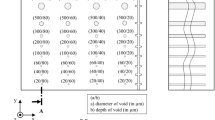Abstract
Research has been carried out to assess the defectoscopic properties of various compositions of powder preparations in order to determine whether they can be used as part of a modern Russian set of defectoscopic materials for luminescent penetrant testing that ensures detection of discontinuities with sensitivity class 1 as per GOST (State Standard) 18442. To improve the efficiency and reliability of flaw detection in hard-to-reach places of complex shaped parts, compositions have been selected that increase the brightness, contrast, and stability of the indication pattern to mechanical action due to high rates of adsorptive and adhesive interactions of the used penetrant fluid and the surface of the tested part.




Similar content being viewed by others
REFERENCES
Kablov, E.N., Innovative developments at FSUE “VIAM” on the implementation of “Strategic directions for the development of materials and processing technologies for the period up to 2030,” Aviats. Mater. Tekhnol., 2015, no. 1, pp. 3–33. https://doi.org/10.18577/2071-9140-2015-0-1-3-33
Kablov, E.N., Modern materials as the basis of innovative modernization in Russia, Met. Evrazii, 2012, no. 3, pp. 10–15.
Kablov, E.N., Russia on the market of intellectual resources, Expert, 2015, no. 28 (951), pp. 48–51.
Kulichkova, S.I., Golovkov, A.N., Kudinov, I.I., and Laptev, A.S., Modern flaw detection materials and equipment and automation of the process of nondestructive penetrant testing, Kontrol’ Diagn., 2019, no. 2, pp. 52–57. https://doi.org/10.14489/td.2019.02.pp.052-057
Kudinov, I.I., Golovkov, A.N., Kulichkova, S.I., and Skorobogat’ko, D.S., Evaluation of the effectiveness of various methods of intensifying the process of penetrant testing using a domestic set of defectoscopic materials, Defektoskopiya, 2019, no. 11, pp. 59–66. https://doi.org/10.1134/S0130308219110071
Kalashnikov, V.S., Kashapov, O.S., Pavlova, T.V., and Istrakova, A.R., Research of welded joints of VT41 alloy obtained by electron beam bonding, Aviats. Mater. Tekhnol., 2014, no. S5, pp. 81–88. https://doi.org/10.18577/2071-9140-2014-0-s5-81-88
Lutsenko, A.N., Perov, N.S., and Chabina, E.B., New stages of development of the Test Center, Aviats. Mater. Tekhnol., 2017, no. S, pp. 460–468. https://doi.org/10.18577/2071-9140-2017-0-S-460-468
OST (Standard) 1 90282-79. Product quality. Nondestructive testing. Dye-penetrat methods, Moscow: FSUE VIAM, 1979.
GOST (State Standard) 18442–80. Nondestructive testing. Dye-penetrant methods, Moscow: Izd. Standartov, 1987.
Migun, N.P. and Gnusin, A.B., Teplovye vozdeistviya pri kapillyarnom nerazrushayushchem kontrole (Thermal Effects with Nondestructive Penetrant Testing), Minsk: Belarus. Navuka, 2011.
Molina, O.G., US Patent 3803051 A, Developer composition for penetrant inspection, Air Products and Chemicals, 1971.
Mlotfijalkowski, A., US Patent 3944828 A, Hydrophobic powdered developer for fluorescent penetrant inspection, Magnaflux Corp., 1974.
White, M.L., US Patent 4295362, Pentaerythritol in dry developer, Magnaflux Corp., 1980.
de Forest, T. and Parker, D.W., US Patent 2806959, Method of detecting surface descontinutes, Switzer Brothers, 1954.
de Forest, T., US Patent 2848421, Indicating powder composition, Magnaflux Corp., 1958.
Switzer, J.L. and Mills, G., US 2920203, Fluorescent penetrant inspection materials and methods, Switzer Brothers, 1955.
Golovkov, A.N., Kulichkova, S.I., Kudinov, I.I., and Skorobogat’ko, D.S., Analysis of existing reference speciments to test the sensitivity of defectoscopic materials during nondestructive penetrant inspection: A review, VIAM: Electron. Nauchn.-Tekh. Zh., 2019, no. 11, Article ID 95. http://www.viam-works.ru. Accessed December 23, 2019. https://doi.org/10.18577/2307-6046-2019-0-11-95-103
GOST (State Standard) R ISO 3452-3-2009. Nondestructive testing. Penetrant testing. Part 3 Test samples. Moscow: Standartinform, 2011.
Author information
Authors and Affiliations
Corresponding author
Additional information
Translated by V. Potapchouck
Rights and permissions
About this article
Cite this article
Ospennikova, O.G., Kudinov, I.I., Golovkov, A.N. et al. Research of Defectoscopic Properties of Powder Compositions for Increasing Efficiency and Reliability of Penetrant Testing of Complex Shaped Parts. Russ J Nondestruct Test 56, 291–297 (2020). https://doi.org/10.1134/S1061830920030079
Received:
Revised:
Accepted:
Published:
Issue Date:
DOI: https://doi.org/10.1134/S1061830920030079




